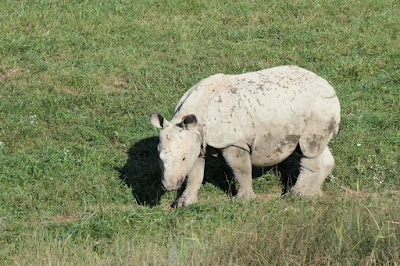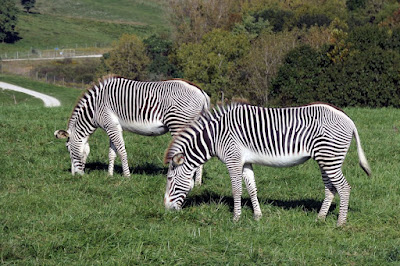This post is the second of two parts, covering our visit to the Wilds on October 1st and 2nd. The first part is here.
Joan and I stepped out of our yurt to yet another beautiful day.
We paused at the fire pit to take in the view as we waited for the breakfast hour to arrive.After filling our stomachs at the Overlook, Joan and I joined the folks waiting for a Wildside Tour, one of the specialty tours. Yesterday we rode in an open-air bus, but for the Wildside we sat in the back of a pickup truck that roams off-road as well as on; it carries up to eight people.
 |
| There were two or three pickups out today. |
 |
| That's our driver/guide. |
The older sibling, no longer fed by his mother, approached.
We gave him some treats.
The other crew got a visit from mama.Baby continued to nap.Further on, we encountered przewalksi's wild horses, originally native to the steppes of Central Asia. The reintroduction of przewalksi's, once extinct in the wild, began in the 1990s.At the carnivore center,the vultures were still warming in the morning sun.
At the Wilds there is plenty of pasture to share; here's a fringe-eared oryx. This muscular antelope is limited to areas of Kenya and Tanzania.
Here is an older gentleman takin, Albert. He lost part of one horn in contests with other males, and is in retirement now, away from the rest of the herd for his own well-being.Who is this?The biggest bird in the world, the ostrich.Next, another highlight of the tour -- the giraffe barn. Giraffes are the tallest living terrestrial animal and the largest ruminant on Earth. Of all the creatures at the Wilds, it is the most sensitive to cold temperatures. There are two subspecies of giraffe here, the Masai, which is endangered, and the Reticulated, the one most often seen in zoos. We climbed to the second story of the barn, in order to be at eye level.Everyone had an opportunity to hold out a lettuce leaf for this Reticulated giraffe, whose long, thick tongue wrapped around the treat.
He hoped for more.Today was warm enough for the giraffes to enjoy the courtyard adjacent to the barn. This photo shows a new baby, born on September 8th.Here's a look at a young, shy Masai giraffe, sporting darker and more jagged patches than the Reticulated.
Back out in the pastures, we encountered scimitar-horned oryx. A species of antelope once widespread in North Africa, it is now extinct in the wild, but reintroduction efforts are underway. The backwards-pointing horns deter or damage predators who leap upon an oryx.
We continued on until we encountered a group of southern white rhinos. Being grazers, they have evolved pendulous heads that they cannot lift high enough to browse on the leaves of trees or tall bushes.
The grass is yummy out here!The bactrian deer and the rhinos easily share a pasture.After 2½ hours in the back of the pickup, we were deposited back at the Overlook. It was time to freshen up and then drive home. What a trip it was!
We continued on until we encountered a group of southern white rhinos. Being grazers, they have evolved pendulous heads that they cannot lift high enough to browse on the leaves of trees or tall bushes.
The grass is yummy out here!The bactrian deer and the rhinos easily share a pasture.After 2½ hours in the back of the pickup, we were deposited back at the Overlook. It was time to freshen up and then drive home. What a trip it was!












































